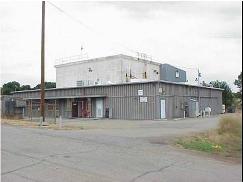Advanced Epithermal Thorium Reactor
The Advanced Epithermal Thorium Reactor (AETR) was housed in Building 4100. The AETR was used to study twenty different nuclear reactor core configurations by using an apparatus which supported a range of geometries
The tests conducted at the AETR measured the results of nuclear criticality which took place when key components were arranged in different ways. The tests conducted under low power conditions so researchers could easily study the experiments. Despite the word "Reactor" within the facility name, the tests did not produce a sustainable nuclear fission reaction and so the facility is more accurately described as a "critical" facility.
Early fuels used in the AETR were thorium or uranium; later tests with high-energy (fast) neutrons were conducted and the name was changed to the Fast Critical Experiment Laboratory (FCEL). The program was completed in 1974.
Building Release
Rockwell International performed a final radiation survey in 1980 to support the request to terminate the NRC license for the facility. The survey results indicated that the building meet release criteria for unrestricted use.
NRC performed a radiological survey in 1980 and verifies the results of the Rockwell International final radiation survey. In July 1980, the NRC issued an order in the Federal Register terminating the license CX-17 for Building 4100. NRC released Building 4100 for unrestricted use in October 1980.
In October of 2001, EPA conducted a document review and verification survey of Building 4100 that confirmed the conclusions of the prior surveys. None of the field measurements indicated the presence of radionuclides above release limits.
In 2001, the Building 4100 septic tank and leachfield were removed. All instrument surveys and wipe tests of the tank and associated piping were non-detect.
The building also housed the Radiation Safety Group's counting lab and instrument calibration lab and will require a final release survey once the counting and instrument calibration labs have been closed.
The 4100 Trench was dug in 1959 and was used for the burning of construction debris from surrounding buildings from 1959 into the 1960s. Because of this historical practice, the area is identified as a solid waste management unit (SWMU) and is included in the RCRA Corrective Action under the oversight of the DTSC.
A radiological survey of the 4100 Trench area was performed in 1988 and concluded that the area met the criteria for unrestricted release.
In 1999 during the RFI sampling some asbestos containing materials and soils impacted with copper, mercury, zinc, and lead were removed. As an precaution additional radiological surveys and soil sampling were also performed during this time. Excavated debris was surveyed and wipe tests were taken to detect radiological contamination. None was found; all results were non-detect for radioactive contamination. The material removed was disposed of at a Class 1 landfill.
DOE has submitted an RFI report to DTSC and is working with the agency to complete necessary sampling in compliance with the 2010 Administrative Order on Consent.
Historical Site Assessment - 4100
